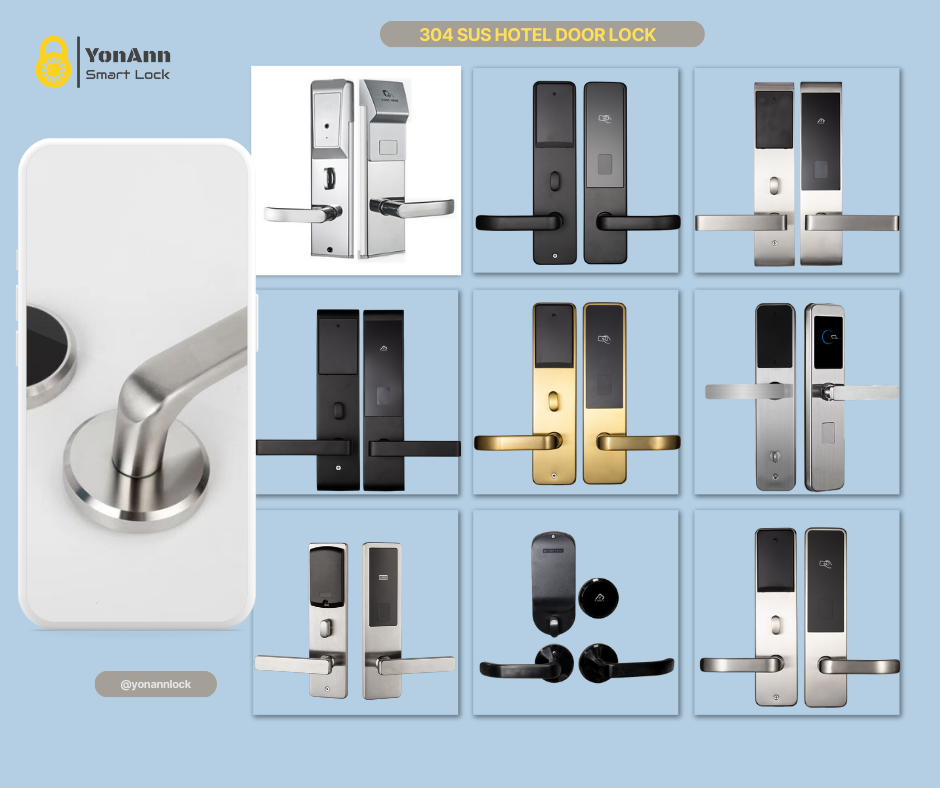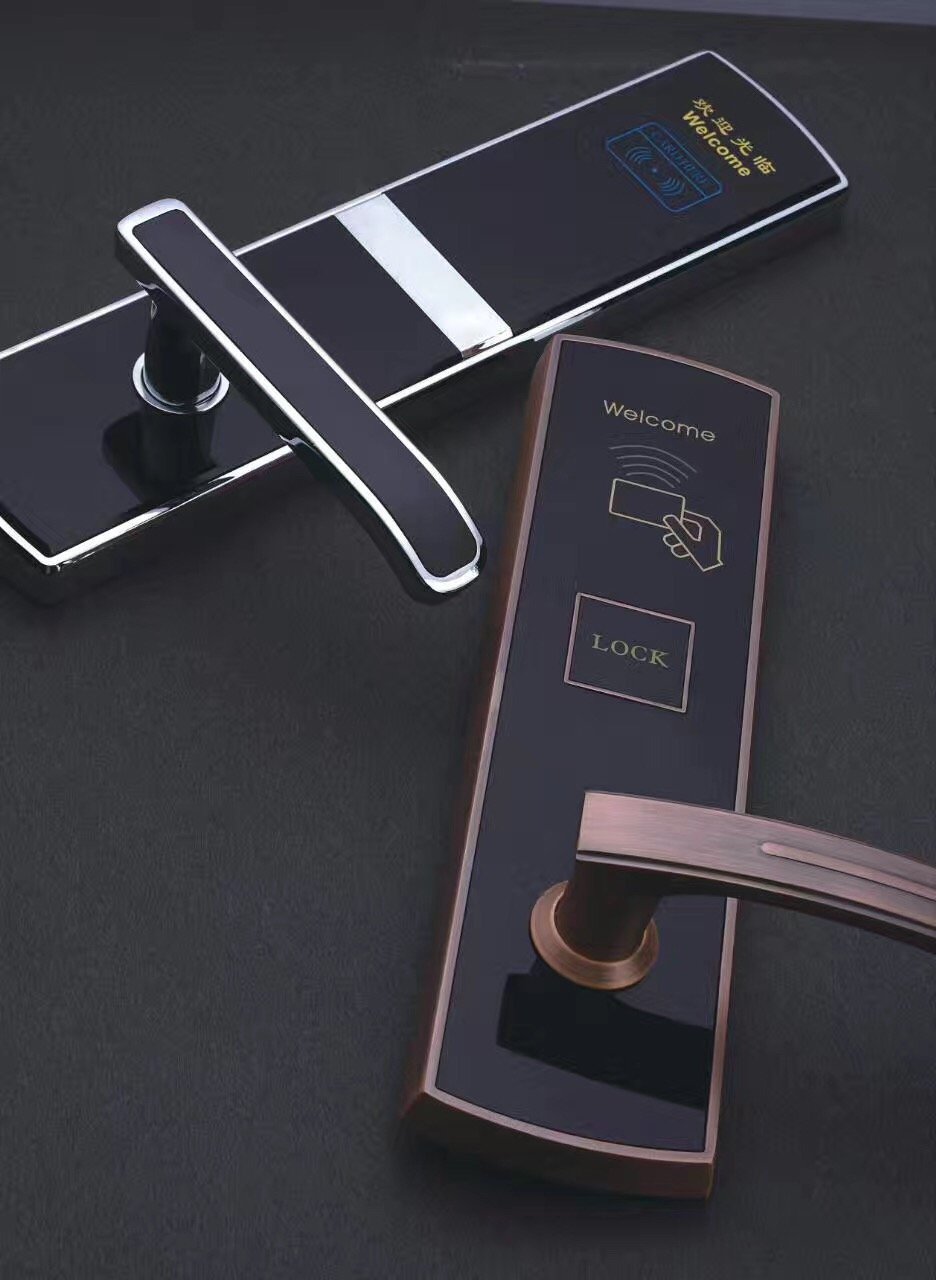Main Material and Technology Application Analysis of Smart Door Locks

The Main Materials of Current Smart Door Lock Applications
There are smart lock materials have many types, especially metal materials, that can be applied to smart door locks, and the materials used in different accessories are also different. The main materials used on the smart door lock body are iron, stainless steel, and copper; the materials used on the panel and the handle mainly include plastic, stainless steel, iron, aluminum alloy, copper alloy, and zinc alloy. Titanium alloy is useful; the internal structure (electronic part, clutch assembly, emergency opening) materials include copper alloy, plastic, stainless steel, etc. At present, our main concern is the material of the lock body, pane, and handle. This article also focuses on the analysis of the materials of the lock body, panel, and handle. The main processes involved mainly include die casting, powder metallurgy, drawing, stamping, cleaning, polishing, electroplating, machining, and other processes.
Lock Body Materials

Let’s first look at the function of the lock body. It is mainly a mechanical device that faithfully executes the opening and closing of the lock. It is one of the main guarantees of safety and durability and is also one of the core parts of the smart door lock. The material requirements It is durable and strong. Therefore, the main material of the current lock body is mainly iron, stainless steel, and some zinc alloys. Copper is mainly used on the lock tongue, and copper is rarely used in internal parts. All stainless steel is expensive and difficult to process, but the price is very expensive. Generally, the processes used are mainly precision casting, stretching, cold pier, etc.; iron is the best cost-effective lock body, so the current mainstream lock body uses Stainless steel for durable parts, such as lock bolts and square rod transmission structures. These are made of stainless steel to increase durability and reliability. Other parts use iron to reduce costs. The application process is the same as that of stainless steel, and some are low All of them are made of iron or stainless steel, and even low-end powder metallurgy is used in the lock bolt processing technology (the quality of high-end powder metallurgy parts is very good, and the cost is also very high. Some stainless steels are also made of powder metallurgy, which must be easy to process. Some), low cost, but slightly less reliable and durable.
The Material of The Panel
This is what many consumers are most concerned about at present, and it is also the most discussed. Generally speaking, the material of smart door locks refers to the material of the panel, which consumers can see intuitively. For example, the material of a certain star is plastic, which is It refers to the material of the panel, and the quality of the material and processing technology of the panel directly determines the two important indicators of the firmness of the panel and the durability of use, and it is the most important embodiment of the appearance value.
The materials currently used on panels mainly include the following: iron, stainless steel, copper, aluminum alloy, zinc alloy, plastic, glass, etc. It is rare to use plastic and glass as the main material.
-
Stainless Steel
The so-called stainless steel panel mainly refers to 304 stainless steel, some use 316 medical grade, 201, and 403 two types we call pseudo stainless steel, in fact it is a kind of iron, do not comment on this aspect as a smart door lock panel One of the main materials used, it has natural advantages in terms of anti-violence and cost, such as high hardness, high strength, and low material price, but its natural disadvantage is difficulty in processing. Generally, the thickness of stainless steel panels is about 2.0mm. The processing technology is mainly applied to bending, stretching, water grinding, polishing, electroplating, and individual precision casting processes. Moreover, due to its material characteristics, stainless steel determines that the current panel is going to two extremes. On the one hand, the minimalist and complex-shaped stainless steel panel has the highest cost, and the cost in the middle is the lowest. For example, the smart door lock in Figure 6 is a representative of minimalism. There is only one bending process plus a surface treatment process. Due to the minimalist shape and tempered glass, the yield is less than 60%. This is a typical case. At the same time complex shapes, such as the stainless steel shape in Figure 7. Therefore, although the fingerprint lock slider is popular with consumers, there are very few stainless steel ones because the process is too complicated. However, according to rumors, several large stainless steel processing factories are now conquering it.
To distinguish between stainless steel and non-stainless steel panels, you can try it with a magnet, 304 and 316 cannot be sucked
Integrated stainless steel panel material intelligent door lock application
Advantages: Durable, simple surface treatment, strong reliability, strong corrosion resistance, not easy to damage the surface, low cost, and moderate weight.
Disadvantages: Difficult to form
Price: It ranks in the middle of all materials, and some are relatively high.
Comprehensive evaluation: Simple smart door locks are the best choice, and the complex appearance is waiting for technological breakthroughs.

Now there are many names, such as space aluminum, magnesium-aluminum alloy, and pure aluminum, but in short, they are all alloy materials formed by adding various materials to aluminum as the base material. The material is light, the strength is moderate, easy to form, and the price is moderate it can be regarded as one of the ideal materials for smart door locks. Smart lock manufacturing processes used are die-casting, extrusion, machining, surface treatment, and other processes. Generally, the thickness of the panel is concentrated at 2mm, and some of them are thicker to ensure strength. It is characterized by easy molding, relatively difficult surface treatment, very high precision requirements for die-casting or machining molding, and high pressure for environmental protection. Have you seen what happened in Wenzhou a few years ago? It is because the aluminum metal is highly active during the polishing process and encounters an open flame. . . . . And I don’t know why, the current market consumers think that the smart door lock made of aluminum alloy is low-end. (Of course, many companies use aluminum to save costs, but it does not mean that aluminum alloy panels are all low-cost, and many high-end products are made of aluminum alloy).
It is generally not easy to distinguish the materials of zinc alloy and aluminum alloy from the appearance, but also from weight.
A comprehensive review of the application of aluminum alloy materials in smart door locks:
Advantages: moderate cost, easy molding, easy coloring, easy processing, the surface oxide layer is not easy to fall off, lightweight!
Disadvantages: high environmental protection pressure, poor market acceptance, relatively difficult surface treatment, poor corrosion resistance, and average material strength;
Price: two extremes of high and low, with low occupying the mainstream
Comprehensive review: Aluminum smart lock is a durable smart lock, and it is widely accepted by the market now.

-
Iron
Here the author also includes so-called stainless steel (201 or 403 and other materials) and iron in our common sense. In fact, in the era of mechanical door locks, iron is the largest user of door lock applications. Its strength, and surface treatment, Although the molding is not as good as stainless steel, it is the most economical and the most cost-effective. However, in the era of smart door locks, iron is surpassed by other materials. Especially zinc alloys. The iron materials with the largest amount are generally composed of iron frames and other material surfaces. Generally, the smart door lock panel of iron base material is mainly used in stamping and surface treatment processes. Its surface treatment, forming technology, and processing technology are between zinc alloy and stainless steel. The die-cast ferroalloy panel is very bulky and has not yet been used in smart door locks.
There is no need to distinguish whether it is an iron material panel. At present, the author has not found very few ferroalloy applications. I want to distinguish the available magnets. It must be iron.
A comprehensive review of the application of iron in smart door locks:
Advantages: high strength, sufficient weight, average molding difficulty, centered surface treatment, centered electroplating;
Disadvantages: general strength, complex materials, general surface corrosion resistance;
Price: There are not many applications, and the price is not transparent
Overall assessment: Living in the middle is embarrassing.
-
Copper Alloy Materials
We generally refer to 59 copper alloy, that is, brass because the hardness of cupronickel (65 copper-nickel alloy is comparable to stainless steel, the price is several times that of stainless steel, and it is rarely used. Pure copper is also copper, which is soft and not suitable. The manufacturing panel is not considered, the author personally thinks that it is an environmentally friendly and durable material, and its molding, surface treatment, and strength are all possible, but it is not widely used in smart door locks at present. The main processes of panel processing include gravity casting, forging, polishing, electroplating, and other processes. Generally, the surface treatment of copper alloy is better than that of zinc alloy, and the surface coloring is easier, but it is not easy to make complex shapes by the forging process, and the process requirements are more complicated, but the advantage is that the mold cost is low.
The way to distinguish between copper and alloy panel materials is to turn the panel over. Generally, copper panels are thicker, at least 2MM or more, and the interior is generally natural, and brass-colored!
A comprehensive review of the application of copper panel smart lock:
Advantages: easy molding, easy surface treatment, sufficient weight, strength to meet the requirements of use, and good consumer acceptance;
Disadvantages: high cost, few manufacturers research copper technology.
Price: slightly higher than the high-end zinc alloy, the overall price is not as high as expected
Comprehensive assessment: If the cost is controlled and the research is in place, the development potential is great.
-
Zinc Alloy
The general zinc alloy we mainly refer to No. 1.2.3.5 zinc alloy material, its cost-effective advantage has led to the current dominance in smart door lock panel materials, occupying the absolute mainstream share. Among them, many advantages such as easy processing, easy forming, low cost, and mature surface treatment make zinc alloy the largest proportion in the field of smart door locks. Its main applied processes are die-casting, polishing, electroplating, machining, and so on. At present, most products of mainstream first-line brands use zinc alloy. Zinc alloy is currently the most researched material in the industry, none of them, but its price gap is also very large, the highest can exceed about half, mainly due to the difference in zinc alloy materials. Good zinc alloys are No. 3 and No. 5 zinc alloys. Imported ones are more expensive, while domestic ones are cheaper. The tonnage of die-casting machines is generally 280 and 400 tons. Zinc alloy must be used in a 150-ton die-casting machine. The surface is not easy to handle, and the inside is easy to oxidize, which greatly affects the use.
The way to distinguish zinc alloy is to turn the panel over as well. The inside is gray, or traces of coloring can be seen. It is usually zinc alloy, and, of course, the weight must be sufficient. The way to distinguish between good and bad is to look at the surface treatment, touch the surface with your hands, there is no burr, and the surface does not fall off, and then look at the reflective line against the strong light, and let the reflective line move. If it is straight and smooth, it should be good.
Comprehensive Review of Zinc Alloy Panel Fingerprint Lock Application
Advantages: easy molding, mature technology, good acceptance, moderate strength.
Disadvantages: difficult surface treatment, good and bad
Price: high, medium, and low-end complete
Comprehensive evaluation: it be replaced by an aluminum smart lock now.

-
Plastic materials
These are generally auxiliary materials, such as the password identification part of smart door locks (fingerprint locks), which are generally used as acrylic materials. A certain type of fingerprint lock on the table is an acrylic (a kind of plastic) with a steel frame on a curved surface, and a large number of plastic materials are used in the panel material of a certain star, but generally speaking, it is still in the status of an accessory, with little impact on performance.
-
Glass

Mainly used in identification panels. At present, fingerprint lock panels based entirely on glass have not been found in the market, and I believe they will not be found in the future. They must be too fragile.
Comprehensive review: All kinds of materials have their advantages and disadvantages, which mainly depend on the psychology of consumption and their own needs. There are no unsatisfied materials and no satisfied needs. This is the current status of the application of smart door lock materials!
Material Comparison Table
|
Material
|
Strength
|
Cost
|
Appearance
|
Process Difficulty
|
Usage Area
|
|
Stainless Steel
|
High
|
High
|
Modern
|
High
|
Body, handle
|
|
Aluminum Alloy
|
Medium
|
Medium
|
Stylish
|
Medium
|
Panels, body
|
|
Zinc Alloy
|
Medium
|
Low–High
|
Versatile
|
Low
|
Panel, handle
|
|
Copper/Brass
|
High
|
High
|
Premium
|
Medium
|
Panels
|
|
Iron
|
High
|
Low
|
Basic
|
Medium
|
Structural parts only
|
|
Plastic
|
Low
|
Low
|
Varies
|
Easy
|
UI covers, sensors
|
Conclusion
Selecting the right material depends on product positioning, cost, durability, and branding. Buyers and designers should consider material impact in terms of longevity and aesthetics.
